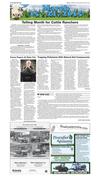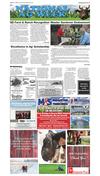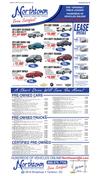12
12 Broadcaster Press
March 17, 2015 www.broadcasteronline.com
March
15 - 21, 2015
Telling Month for Cattle Ranchers
BROOKINGS - The month of March signals two seemingly
very different events, basketball playoffs and for many South
Dakota ranchers, the peak of calving season.
“On the surface they may not have much in common, but
they both represent the end point of a lot of time, energy and
resources,” said Warren Rusche, SDSU Extension Cow/Calf
Field Specialist.
Rusche takes this analogy one step further. “The goal of a
basketball team is to make a deep run in the playoffs and the
goal of a rancher is to save as many calves as possible,” he
said.
Preparation, Rusche said is the key component for
success in both fields. “For a rancher, success during calving
is critical. More than 60 percent of calves that are born and
die before weaning are either born dead or are lost within the
first 24 hours of birth,” said Rusche quoting data from the
USDA National Animal Health Monitoring System. “Calving
difficulty is the most significant cause of death.”
Preparation = Success
“Being well prepared for the start of calving season can
make a tremendous difference in successfully getting live
calves on the ground,” Rusche said.
He explained that it is a lot easier to get all the necessary
supplies on hand and in place ahead of time, rather than
scrambling in the dark when the first heifer needs some help.
To ensure timeliness of preparation, he suggested cattle
producers review gestation tables as well as breeding
and turn-out dates to predict when the first calves will be
expected.
“However, some cows don’t read the book,” Rusche said.
“It’s not at all uncommon for genetic lines that have been
selected for easier calving and lower birth weights to show a
tendency for shorter gestation as well.”
In those cases, he said it would be prudent to be ready
a week to 10 days earlier than what the gestation table
suggests.
Ensuring that everyone on the team understands the
game plan and their role is also important. “Going over the
plan for calving season with the entire team is a good idea
to make sure that everyone is on the same page, even if the
plan hasn’t changed and even if the team is only one person,”
Rusche said.
He added that factors such as when to provide assistance
and knowing when to call your veterinarian can impact not
only this year’s production, but future calf crops as well.
Rusche referenced research from the Ft. Keogh Research
Station in Miles City, Mont., which showed that heifers which
were assisted later during labor had a 19 percent reduced
pregnancy rate compared to heifers that were helped within
a half hour (Table 1).
Even in cows, the research demonstrated a 9 percent
improvement in pregnancy rates by assisting earlier.
“Given the value of bred females this year, being prepared
to assist early will help increase the odds of getting cattle
bred back in a timely manner and lower the losses from
premature culling,” Rusche said.
Reviewing the actual procedures of delivering calves can
also be useful, even if a producer has years of experience.
Below are some general recommendations from Dr. Russ
Daly, SDSU Extension VeterinarianAssociate Professor, and
State Public Health Veterinarian:
Take a short pause after the chest of the calf is delivered
before pulling again. This mimics what happens in a normal
delivery. When the calf takes its first breath it begins to
transition away from oxygen from the umbilical cord to
oxygen from the air.
A slight rotation (45 degrees) often allows the hips to pass
more easily.
Use a piece of straw or vigorous rubbing to encourage
the calf to breathe. One might think that picking up the calf
with his head down would help get fluid out of his breathing
passages, but actually that creates increased pressure on the
lungs making it more difficult to breathe.
Call for assistance if one can’t determine how to correct
the problem or if 30 minutes of assistance have gone by
without significant progress.
- See more at: http://igrow.org/news/telling-month-forcattle-ranchers/#sthash.6jOKT0wI.dpuf
n SDSU iGrow
Kenny Rogers At State Fair Trapping Pollutants With Natural Soil Components
HURON –The
South Dakota State
Fair announces Kenny
Rogers and the John
Conlee Show will
perform at the Fair
Grandstand on Friday,
Sept. 4, 2015.
Known for his
trademark raspy
vocals, Country Music
Hall of Fame member
Kenny Rogers is one
of music’s legionary
voices with classic
hits like “Lucille,” “The
Gambler,” “Islands
In The Stream” and
“Lady.” Rogers has
sold more than
120 million albums
worldwide during
his career of over 50 years,
including one Diamond,
19 Platinum and 31 Gold
albums.
With three Grammys, 18
American Music awards,
eight Academy of Country
Music awards, six Country
Music Association awards
and 11 People’s Choice
awards, it’s obvious Kenny
Rogers has swooned the
country and pop music
fields for many years.
“It’s an honor to have a
country legend like Kenny
Rogers play at the State
Fair,” said SDSF manager,
Peggy Besch. “Our classic
country shows do well, so
we are happy to bring Kenny
Rogers and John Conlee to
fairgoers.”
John Conlee is one of
music’s great storytellers
with hits like “Rose Colored
Glasses,” “Common Man”
and “Got My Heart Set on
You.” Of the John Conlee
Show’s 29 released singles,
26 of them have charted
in the top 20 or higher on
national country charts,
with eight of them reaching
number one.
Pre-sale on tickets will
begin June 15 for backrest
holders followed by Friends
of the Fair ticket sales on
June 18. General public
ticket sales will begin June
22.
The 2015 South Dakota
State Fair will run from
Thursday, Sept. 3, through
Monday, Sept. 7. Channel
Seeds preview night will be
Wednesday, Sept. 2. This
year’s theme is “Sew it.
Grow it. Show it.” For more
information on State Fair
events, contact the Fair
office at 800-529-0900, visit
www.sdstatefair.com or
find them on Facebook or
Twitter.
Agriculture is South
Dakota’s No. 1 industry,
generating over $25.6 billion
in annual economic activity
and employing more than
115,000 South Dakotans. The
South Dakota Department of
Agriculture’s mission is to
promote, protect, preserve
and improve this industry
for today and tomorrow.
Visit us online at http://
sdda.sd.gov or find us on
Facebook and Twitter.
BROOKINGS - Using
natural soil components
to trap pollutants will
allow producers to control
soil contaminants and
reuse draining water while
protecting their agricultural
crops, according to
Mohamed Elsayed, a
Fulbright Postdoctoral
Scholar at South Dakota
State University’s chemistry
and biochemistry
department.
Elsayed concentrates
some humic acid fractions
by evaporating the water.
His research seeks to use
natural soil components
to trap pollutants and
allow producers to irrigate
their crops with recycled
drainage water.
Elsayed uses
ultrafiltration techniques
to break humic acid down
into smaller molecules that
can then combine with clay
minerals in the soil to trap
pollutants.
A researcher from
the Soil Water and
Environmental Research
Institute at the Agricultural
Research Center in Egypt,
will present his work at the
American Chemical Society
National Meeting March 2226 in Denver. “I am honored
that Mohamed chose my
group as the place to
spend his fellowship,” said
Jim Rice, head of SDSU’s
Department of Chemistry
and Biochemistry. “It’s
another sign of the strong
international recognition
that our research program
is building.” If crops are
sown in polluted soil,
the plants absorb the
contaminants, Elsayed
explained. These are then
transferred to humans
when they consume the
vegetables or grains.
Because of water shortages
in Egypt, Elsayed said, “we
need to use water again and
again, but before we reuse
it, we need to clean it.” His
research seeks to increase
the ability of humic acid to
adsorb or trap pollutants in
combination with either of
two clay minerals—kaolinite
or montmorillonite. Humic
acid is one of the major
organic components in
soil and is also used as
fertilizer. “The idea is to
use natural materials to
reduce the pollutants,”
he explained. “Natural
components are cheaper,
more easily available.”
Plus, artificial ingredients
run the risk of adding to
the pollution problems—
natural ingredients don’t.
By breaking humic acid
into smaller molecules, a
process called fractionation,
Elsayed hopes to improve
the interaction between
humic acid and clay
minerals and, therefore,
their ability to trap
pollutants, particularly
heavy metals. This project
is a continuation of his
doctoral research. If
fractionation produces good
results, the next step will be
to determine the optimum
humic acid fractionation
combination for each clay
mineral to enhance the
trapping process, Elsayed
explained. The long-range
vision is for producers to
apply humic acid, either
in solid or liquid form, to
enhance soil properties.
“These compounds would
capture the heavy metals
and organic pollutants so
the plant won’t take it up,”
he said. The resulting crop
would be contaminant-free.
n SDSU iGrow
Farms in Group 4 with 3,500 (11 percent of the total) dropped by 7.9 percent, had
7.2 million acres in farms with an average of 2,057 acres per farm.
Farms in Group 5 with 3,300 (10.4 percent of the total) increased by 13.7 percent,
had 11.2 million acres in farms and an average of 3,394 acres.
Page ?
Finally, Group 6 with 2,500 (7.9 percent of the total) increased by 4.2 percent, with
13.1 million acres in farms and an average of 5,240 acres.
“From this analysis it can be inferred that in South Dakota it is again Group 1 (negative 6.7 percent) which has the greatest
risk to its sustainability,” Garcia said. “Group 2 on the other hand showed an interesting, encouraging growth since 2013.”
In spite of South Dakota’s larger operations, South Dakota farms that fit into sales groups 1 and 2 make up 56.7 percent of
the total farms in the state.
“Oddly enough it was the middle-sized farms that took the greatest hit in numbers. Both groups 3 and 4 showed quite a
significant reduction with negative 2.2 and negative 7.9, respectively,” he said. “Similar to the rest of the country, farms in
groups 5 and 6 increased and were responsible for more acres farmed, mostly because more farms entered this group and not
because of a significant increase in farm size.”
Farms that sell less than $10,000 in agricultural products have their sustainability compromised both in the U.S. and in
South Dakota, explained Garcia. “These farms are roughly under 86 and 145 acres for the U.S. and South Dakota, respectively.
On these smaller operations, sales may compromise the adoption of cutting edge technologies and the reaping of the benefits
of efficiencies of scale,” Garcia said. “Larger farms with greater overall sales are usually more attractive to the agricultural
allied industry with increased technical support which entice them to farm more acres usually resulting in higher sales.”
2x1
However, Garcia added, smaller operations, like those in groups 1 and 2 combined still constitute one-third (31.1 percent)
of all U.S. farmland, and more than 80 percent of U.S. farms.
“This makes Group 1 and 2 farms a significant group for U.S. agriculture. South Dakota also shows the relevance of these
two groups which combined represent a relatively smaller portion of the acreage at 14.5 percent but more than half of the
total farms in the state (56.7 percent)” he said.
n FARM SIZE, From
Broa
dcasteronline
.com
n SOUTH DAKOTA STATE NEWS
n SOUTH DAKOTA STATE NEWS
Go your own way.
With eight models and a long list of options to choose from, there’s a top-quality Kubota RTV
for your own unique mix of outdoor work and rugged adventure. Schedule a test drive today.
RTV114%CP;& More Room
RTV$%%& Easy to Haul
Quickly converts from 2- to 4-passenger seating.
Compact gasoline model ?ts in the back of a long-bed pickup.
Broadcasteronline.c
om
THE STRIP TILL
ADVANTAGE
3x1
Broadcasteronline.c
om
Elk Point, SD
SERVICES AVAILABLE
• Custom Strip Till
• GPS Soil Sampling
• Soil Fertility Planning
• Crop Scouting
• Variable Rate Fertility
Call to discuss Spring Strip Till options
RTV11%%& All-Weather Cab
RTV:%%;T& Pick Your Finish
Up your comfort factor with a factory-installed cab.
Diesel model comes in Kubota orange or Realtree® camouflage.
JOEY HANSON
Crop Consultant/CCA
605.659.4783 • joey.hanson@diversifiedagronomy.com
Mar$%s Mac)iner-
4x1
Mar$%s Mac)iner- .nc.
?????????????????
?????????????????
??????????????
• Highly efficient use of fertilizer
by directly placing below the
crops roots and minimizes
tie-up unlike broadcast
applications
• Dual placed nutrients that
promotes early, healthy root
development and creates an
optimum, fertile environment
for seed
• Increases yield while lowers
inputs such as labor, fuel, and
reduced wear and tear on
your equipment
• Offers best of both worlds:
Conservation aspects of no till,
plus, increased yields and soil
quality of conventional tillage
??????????????
????????????????
??????????
www.kubota.com
©Kubota Tractor Corporation, 2012
Realtree® is a registered trademark of Jordan Outdoor Enterprises, Ltd.
CUSTOM STRIP TILL • CALL 605.659.4783

















 Previous Page
Previous Page





